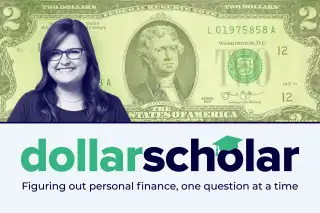Dollar Scholar Asks: What's the Deal With $2 Bills?

This is an excerpt from Dollar Scholar, the Money newsletter where news editor Julia Glum teaches you the modern money lessons you NEED to know. Don't miss the next issue! Sign up at money.com/subscribe and join our community of 160,000+ Scholars.
The other day, I went to a drag show in Brooklyn where one of the queens mentioned that an audience member had tipped her with a $2 bill. She was shocked, and so was I: I’d always thought $2 bills were incredibly rare. In fact, I used to keep one in my wallet as a kid in the ‘90s because it felt so special.
Mentally, I’ve been putting $2 bills in the same category as $100s — obviously, I know they exist, but I don’t come into contact with them often enough to view them as everyday currency.
Now, though, I’m re-evaluating that belief.
Are $2 bills actually rare?
Let’s start off with some history: Two-dollar banknotes are technically older than the United States itself. The original bills in that denomination were authorized by the Continental Congress before the Declaration of Independence was even signed.
Once the U.S. was formally established, the federal government first issued a $2 note in 1862. At that point, it had a portrait of Treasury Secretary Alexander Hamilton on it. Thomas Jefferson, the third president, started appearing on $2 bills beginning in 1869.
They never really took off. Despite brief bouts of popularity in the 1890s and 1940s, the $2 bill has had a pretty rough time breaking into the mainstream. For decades, its price point was associated with bribes, prostitution and gambling. The New York Times called the $2 bill “Treasury’s jinx” in 1925; more recently, CNN denounced it as “the unloved child of paper currency.”
Even the Bureau of Engraving and Printing — the agency with the Treasury Department in charge of printing bills — acknowledges this reputation.
“For most of their history, $2 notes have been unpopular, being viewed as unlucky or simply awkward to use in cash exchanges,” the BEP writes in a fact sheet. “$2 notes were often returned to the Treasury with corners torn off, making them mutilated currency and unfit for reissue.”
The Treasury actually stopped printing them in 1966 due to lack of demand, Peter Treglia, vice president and managing director of currency at Stack’s Bowers Galleries, tells me. In 1976, $2 bills were brought back for the Bicentennial, though, and that gave them a slight resurgence…
…as a collector’s item.
Today, “It’s not uncommon for them to be given as a good luck charm” or a gift, he says, but $2 bills are simply not circulated in regular commerce.
There are different theories as to why, but the result is undeniable: When people come across a $2 bill, they tend to hold onto it. They don't spend it.
Why people think $2 bills are special
Yes, it might be unusual to spot $2 bills in everyday life — but are they rare? Nope, according to Steven Roach, numismatic educator with the American Numismatic Association, a nonprofit that encourages the study and collection of coins, paper money and related objects. He tells me that $2 bills are “not rare in terms of quantity.”
Every year, the Federal Reserve Board of Governors places an order for currency from the BEP based on demand (and how much old currency will be destroyed due to wear and tear, design changes, etc.). The BEP then fulfills that order and delivers the banknotes to Federal Reserve cash offices, which then distribute them through banks, credit unions and the like.
During the 2023 fiscal year, the BEP produced roughly 2.4 billion $1 bills, 1.3 billion $100 bills and 882 million $5 bills.
It also made 128 million $2 bills — obviously, not a lot compared to other denominations.
Some years, the BEP doesn’t produce any $2 bills at all. Just since the turn of the century, this happened in 2021, 2020, 2017, 2018, 2013, 2011, 2010, 2009, 2008, 2007, 2005, 2003, 2002, 2001 and 2000. (Whew.)
(According to the latest Federal Reserve data, there are 1.5 billion $2 bills in circulation. For context, there are 14.3 billion $1 bills and a whopping 18.5 billion $100 bills in circulation.)
But Roach says just because the government is printing them doesn’t mean they're being used to buy stuff or make change.
“It's not as common as the dollar bill — or $5, $10, $20, $100 — to circulate,” Roach says. “[People] don’t see it too often, and because of that, they get the perception that it must be rare.”
Most of the bills that aren’t out in the wild are in bank vaults, which means they’re not especially difficult to get, Treglia says. All I have to do is go to the bank and request them: an accessibility that kind of takes away from the mystery of it all.
The bottom line
$2 bills may seem special because they’re not used in most ordinary transactions. But statistically speaking, they’re not.
“People see them, and they’re like, ‘What is this?’” Treglia says. “They're collectible simply because they’re part of U.S. history.”
More from Money:
Will I Spend Less if I Force Myself to Use Cash?